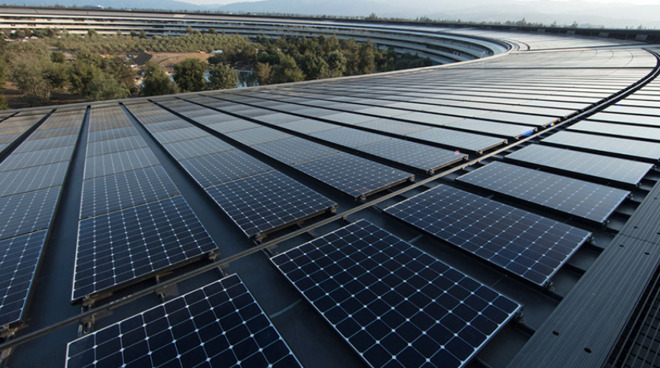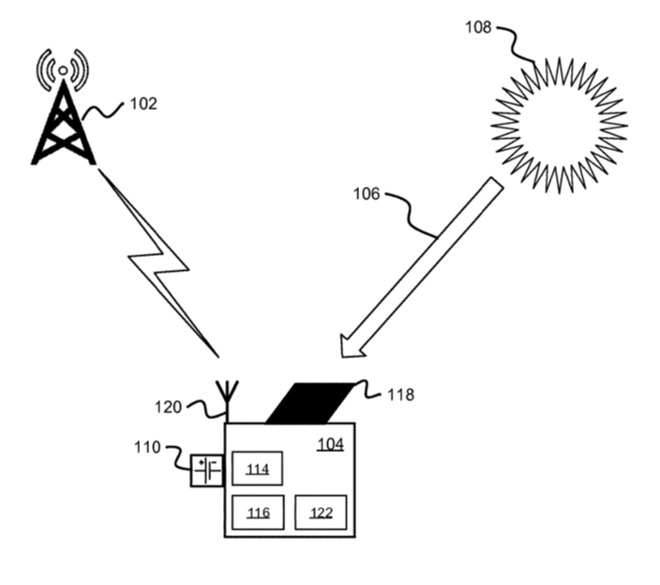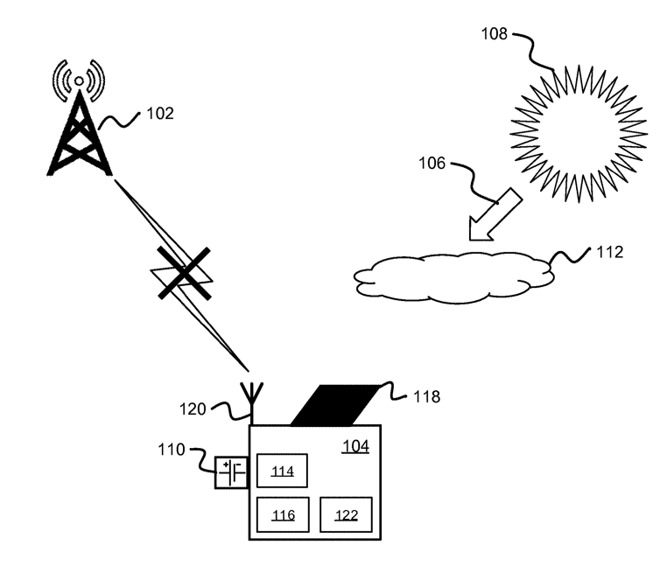Apple was working on self-charging, cellular base stations before axing AirPort
Apple was working on Wi-Fi or cellular base stations that keep themselves charged and powered without either AC power, or human intervention -- and which can rejoin the network after a loss of power.

Apple Park's solar panel roof. The company is looking at ways to better use energy-harvesting devices even at much smaller scale
It doesn't sound like a very difficult technical problem. If you've regularly got bright sunlight, popping a solar panel on to a cellular base station, seems a sensible, practical and even green thing to do. It doesn't even have to be solar power, devices could be driven by the wind.
Except the wind drops, the sun goes in, and current wireless base stations don't cope nicely when they suddenly lose power. Apple has now been granted a patent -- US Patent No 10,716,114, "Outage notification and context preservation for energy-harvesting devices" -- which aims to address this, chiefly for cellular base stations. It does also refer to Wi-Fi and Bluetooth, and it's possible that Apple is still looking to use this technology, but even though the patent has just been granted, it was filed in 2015.
As with all patents, this one attempts to cover every possible application of the claim by making its descriptions as broad as it can. So throughout the document, Apple refers to energy-harvesting devices (EHDs), which can be solar panels, wind turbines or more. It also refers broadly to wireless rather than specifying Wi-Fi or solely cellular, but it's always the case that this applies to a powered device that sits on a wireless network.

Detail from the patent showing how when the sun shines, everything works.
"Since environmental conditions and other phenomena from which EHDs harvest energy can vary," says the patent, "the rate at which EHDs harvest energy can also vary accordingly." Apple goes on to note that what usually helps is to have a battery in the device "that can be used to store energy harvested by the EHD so that the energy can be available for operations performed at the EHD."
"Nevertheless, if the rate at which the EHD harvests energy falls below the rate at which energy is consumed and/or lost by the EHD for period of time long enough to deplete the energy stored in the energy-storage device," it continues, "the amount of energy available to the EHD may decrease to a point where energy-consuming operations at the EHD need to be temporarily halted until sufficient energy is again available."
In other words, if there isn't enough power coming in directly right now and there isn't enough in the battery to draw on, the device is going to stop working. That's obviously a problem, but it's not the problem Apple is directly trying to fix.
"Wireless operations, in particular, may need to be temporarily halted," continues the patent. "This poses a problem because the protocols that cellular base stations currently observe when wireless connections are interrupted are not designed to efficiently address the situation in which an EHD frequently halts--and subsequently seeks to resume--wireless communications."
Currently, a device will keep soldiering on until it has no power left, then it will shut off immediately. Data that was being sent to or via that base station then clearly can't get to it or can't be relayed on to another device. According to Apple, though, that data is then typically lost because nothing tells the transmitter that something is wrong, or at least not quickly enough.
"In general, cellular base stations are designed to deal with interruptions of wireless connections that can be due to many different issues, such as poor channel conditions, excessive interference, and movement of wireless devices out of coverage areas," says the patent.

Detail from the patent showing in some graphic detail that when the sun goes in, a network connection can drop
"Since some interruptions may be only momentary," it continues, "if a cellular base station does not receive an acknowledgment from a wireless device verifying that... data sent to the wireless device via a wireless connection was received, the cellular base station may resend... multiple times and wait for an acknowledgment before inferring that the wireless connection has been lost or dropped."
As well as the risk of lost data, Apple says that "cellular base station's repeated sending of the... data can be wasteful." Alongside whatever data a user was sending, a connection that drops like this can also mean the loss of information about the connection itself. The device may not be recognized when it powers back up again.
What is needed, then, and what Apple proposes in this patent, is that a wireless device powered by energy-harvesting methods, tells the network when it's going to go dark. Then when it has charged up enough, it "can send a connection-resumption communication to the cellular base station indicating that the level of energy at the EHD is sufficiently high for the wireless connection to be resumed."
The patent goes into detail about different methods that a base station device can alert a network, and also provides examples of very many types of devices that could use this.
Ultimately, though, what it means for users is that it's going to be possible to place devices in areas that get, for instance, sunlight, but are otherwise awkward to reach. That could mean wireless stations being put in more secure areas, or just less convenient ones such as strung out in a line across a large plot of land.
With the devices never having to be manually charged up or have their batteries replaced, they could be placed once with less regard for anyone having to regularly service them.
The patent is credited to six inventors, including two -- Maruti Gupta and Raath Vannithamby -- who have previously been listed on a related "Communication state transitioning control" patent.
Apple has previously experimented with base station charging, but less to keep those powered, and more to make Wi-Fi routers that can charge up iPhones from a distance.

Apple Park's solar panel roof. The company is looking at ways to better use energy-harvesting devices even at much smaller scale
It doesn't sound like a very difficult technical problem. If you've regularly got bright sunlight, popping a solar panel on to a cellular base station, seems a sensible, practical and even green thing to do. It doesn't even have to be solar power, devices could be driven by the wind.
Except the wind drops, the sun goes in, and current wireless base stations don't cope nicely when they suddenly lose power. Apple has now been granted a patent -- US Patent No 10,716,114, "Outage notification and context preservation for energy-harvesting devices" -- which aims to address this, chiefly for cellular base stations. It does also refer to Wi-Fi and Bluetooth, and it's possible that Apple is still looking to use this technology, but even though the patent has just been granted, it was filed in 2015.
As with all patents, this one attempts to cover every possible application of the claim by making its descriptions as broad as it can. So throughout the document, Apple refers to energy-harvesting devices (EHDs), which can be solar panels, wind turbines or more. It also refers broadly to wireless rather than specifying Wi-Fi or solely cellular, but it's always the case that this applies to a powered device that sits on a wireless network.

Detail from the patent showing how when the sun shines, everything works.
"Since environmental conditions and other phenomena from which EHDs harvest energy can vary," says the patent, "the rate at which EHDs harvest energy can also vary accordingly." Apple goes on to note that what usually helps is to have a battery in the device "that can be used to store energy harvested by the EHD so that the energy can be available for operations performed at the EHD."
"Nevertheless, if the rate at which the EHD harvests energy falls below the rate at which energy is consumed and/or lost by the EHD for period of time long enough to deplete the energy stored in the energy-storage device," it continues, "the amount of energy available to the EHD may decrease to a point where energy-consuming operations at the EHD need to be temporarily halted until sufficient energy is again available."
In other words, if there isn't enough power coming in directly right now and there isn't enough in the battery to draw on, the device is going to stop working. That's obviously a problem, but it's not the problem Apple is directly trying to fix.
"Wireless operations, in particular, may need to be temporarily halted," continues the patent. "This poses a problem because the protocols that cellular base stations currently observe when wireless connections are interrupted are not designed to efficiently address the situation in which an EHD frequently halts--and subsequently seeks to resume--wireless communications."
Currently, a device will keep soldiering on until it has no power left, then it will shut off immediately. Data that was being sent to or via that base station then clearly can't get to it or can't be relayed on to another device. According to Apple, though, that data is then typically lost because nothing tells the transmitter that something is wrong, or at least not quickly enough.
"In general, cellular base stations are designed to deal with interruptions of wireless connections that can be due to many different issues, such as poor channel conditions, excessive interference, and movement of wireless devices out of coverage areas," says the patent.

Detail from the patent showing in some graphic detail that when the sun goes in, a network connection can drop
"Since some interruptions may be only momentary," it continues, "if a cellular base station does not receive an acknowledgment from a wireless device verifying that... data sent to the wireless device via a wireless connection was received, the cellular base station may resend... multiple times and wait for an acknowledgment before inferring that the wireless connection has been lost or dropped."
As well as the risk of lost data, Apple says that "cellular base station's repeated sending of the... data can be wasteful." Alongside whatever data a user was sending, a connection that drops like this can also mean the loss of information about the connection itself. The device may not be recognized when it powers back up again.
What is needed, then, and what Apple proposes in this patent, is that a wireless device powered by energy-harvesting methods, tells the network when it's going to go dark. Then when it has charged up enough, it "can send a connection-resumption communication to the cellular base station indicating that the level of energy at the EHD is sufficiently high for the wireless connection to be resumed."
The patent goes into detail about different methods that a base station device can alert a network, and also provides examples of very many types of devices that could use this.
Ultimately, though, what it means for users is that it's going to be possible to place devices in areas that get, for instance, sunlight, but are otherwise awkward to reach. That could mean wireless stations being put in more secure areas, or just less convenient ones such as strung out in a line across a large plot of land.
With the devices never having to be manually charged up or have their batteries replaced, they could be placed once with less regard for anyone having to regularly service them.
The patent is credited to six inventors, including two -- Maruti Gupta and Raath Vannithamby -- who have previously been listed on a related "Communication state transitioning control" patent.
Apple has previously experimented with base station charging, but less to keep those powered, and more to make Wi-Fi routers that can charge up iPhones from a distance.

Comments
The point here is not to take anything away from Apple’s innovation by noting that the techniques and methods described in their patent have been done before. Quite the contrary. It’s to point out that if you are an inventor, or more precisely, an innovator there is tremendous value in looking outside of your own problem domain to see how others have solved similar or adjacent problems, or pieces of problems that you are trying to solve in your problem domain. Building on top of and extending on the work/insights of others is tremendously valuable and efficient. Why start at square one if you don’t have to? It’s redundant and completely wastes the benefits of scientific discovery and evolution. Several recent innovations from Apple are clearly benefiting from lessons learned in other industries like aerospace (LIDAR, sonar), industrial control (inductive power transmission, RFID), and medical (ECG, heartbeat monitoring). This is a good thing and Apple should be commended for thinking and discovering outside the box of their primary problem domain. And no, it’s not copying - there is no such thing as one universal “wheel” that applies to every application in every problem domain. It’s just being smart.
This doesn't sound a lot anything that Apple would be involved in to be honest, so I'd agree that it's most likely just some paperwork left over from the Intel patent buyout.